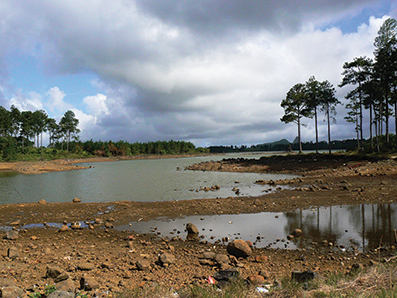The water crisis in Iran, which manifested itself in large after Zayandehrud River and Lake Urmia dried up, highlights improper economic planning and will continue to cripple all future economic plans. Economists must not therefore turn a blind eye on this catastrophic environmental disaster.
Iran is largely an arid and water-scarce country. The amount of annual renewable water resources in the country is 1,600 cubic meters (nearly one fifth of the international average of 7,600 cubic meters).
According to a report published by Ta’adol (Balance) newspaper, of all available water resources, 93 percent is consumed in agriculture, 4 percent in industries, and 3 percent for domestic purposes. The international average for water consumption in agriculture, however, is 50 percent.
To manage the crisis, a number of solutions should be considered. Firstly, water-hogging crops and fruits such as rice, watermelon, etc. should be farmed proportional to water prices. In water-scarce countries, water should not be wasted on growing products which can be imported with lower costs. When a country imports water-hogging crops instead of producing them, it is saving water. The procedure, referred to as virtual water trade, needs to be adapted in Iran.
Strategic products could also be farmed outside the country. For instance, with Iranian investment wheat, also a water-hogging product, could be produced in Kazakhstan, Tajikistan, or Africa.
Next, farming methods within the country are in need of major modification. Basin flood irrigation, in which more than 65 percent of irrigating water goes to waste, is oddly the most common method used in Iran. Irrigation systems need to be optimized and modern techniques should replace traditional methods. Introducing mechanized systems can help relieve the crisis.
Over-withdrawal of ground water has endangered ground water aquifers. Ground water withdrawal, especially in prohibited plains must stop.
Iranian agriculture is far from economical. Water productivity for every cubic meter of water is 850 grams at most, while the international average is between 2-2.5 kilograms. Also, every cubic meter of water used in agriculture creates 35 cents in added value while the international average is a dollar. Water prices for domestic, agricultural, and industrial use should be calculated based on regional water costs and value.
Industries are also in need of comprehensive planning. Spatial planning should determine where certain industries should be set up. Industries with high water consumption (such as steel and iron) should not logically be placed in semi-arid areas such as Yazd and Isfahan. Such industries must be shifted to northern and southern coasts where abundant sea-water resources are available. Although the entire industries cannot be shifted, certain sectors should. The process would no doubt be costly, but there is no other option.
Finally, the key solution, which can help preserve resources and revolutionize the agriculture industry is to reassess and remodel water management. Currently, water management is practiced provincially. The share of water in each province depends on its political bargaining power. This type of management is faulty and disastrous.
Provincial management would only work if each province pays money for the water it imports. The method referred to as “water bourse” should be followed. In other words, each province should be required to sell the water it exports and pay for the water it imports. If such a system is implemented, automatically industries with high water consumption will not be stationed at water-scarce areas.


